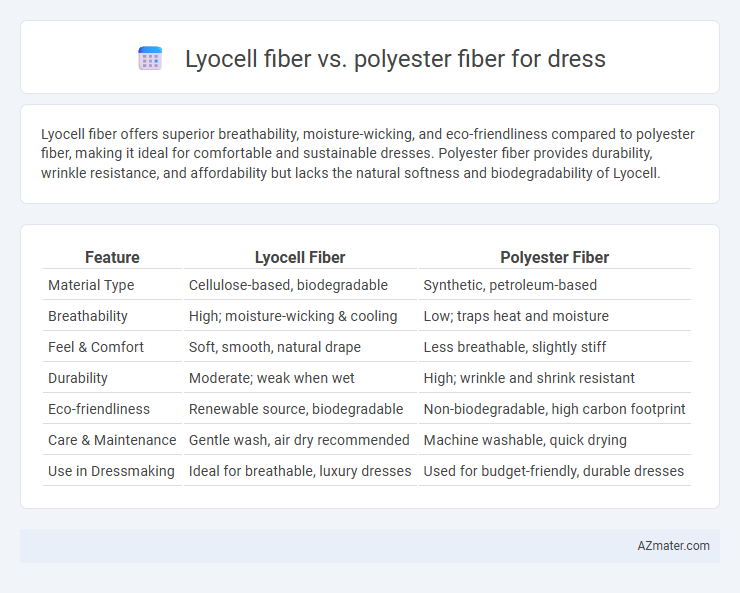Lyocell fiber offers superior breathability, moisture-wicking, and eco-friendliness compared to polyester fiber, making it ideal for comfortable and sustainable dresses. Polyester fiber provides durability, wrinkle resistance, and affordability but lacks the natural softness and biodegradability of Lyocell.
Table of Comparison
| Feature | Lyocell Fiber | Polyester Fiber |
|---|---|---|
| Material Type | Cellulose-based, biodegradable | Synthetic, petroleum-based |
| Breathability | High; moisture-wicking & cooling | Low; traps heat and moisture |
| Feel & Comfort | Soft, smooth, natural drape | Less breathable, slightly stiff |
| Durability | Moderate; weak when wet | High; wrinkle and shrink resistant |
| Eco-friendliness | Renewable source, biodegradable | Non-biodegradable, high carbon footprint |
| Care & Maintenance | Gentle wash, air dry recommended | Machine washable, quick drying |
| Use in Dressmaking | Ideal for breathable, luxury dresses | Used for budget-friendly, durable dresses |
Introduction to Lyocell and Polyester Fibers
Lyocell fiber, derived from sustainably sourced wood pulp, offers exceptional breathability, moisture-wicking properties, and a silky texture ideal for comfortable dress fabrics. Polyester fiber, a synthetic polymer made from petroleum-based products, provides durability, wrinkle resistance, and color retention, commonly used in affordable, easy-care dresses. The choice between Lyocell and Polyester fibers impacts dress performance, sustainability, and comfort, with Lyocell favored for eco-friendly fashion and Polyester valued for resilience.
Origins and Production Processes
Lyocell fiber is derived from sustainable wood pulp through a closed-loop solvent spinning process, minimizing environmental impact and chemical waste. Polyester fiber originates from petrochemical sources and is produced via a high-energy-intensive polymerization process involving synthetic polymers. The renewable sourcing and eco-friendly manufacture of Lyocell contrast sharply with the fossil fuel dependency and higher carbon footprint associated with polyester production.
Environmental Impact Comparison
Lyocell fiber, derived from sustainably managed eucalyptus trees, offers a biodegradable and low-impact alternative to polyester, which is a petroleum-based synthetic fiber contributing to microplastic pollution and high carbon emissions. The closed-loop production process of Lyocell recycles water and solvents, significantly reducing environmental footprint compared to polyester's energy-intensive manufacturing and non-biodegradability. Choosing Lyocell dresses supports reduced reliance on fossil fuels, lower greenhouse gas emissions, and minimized landfill waste in the fashion industry.
Comfort and Wearability
Lyocell fiber offers superior breathability and moisture-wicking properties compared to polyester, making it ideal for dresses worn in warm or humid conditions. Its soft, smooth texture enhances comfort by reducing skin irritation, while polyester tends to trap heat and causes discomfort during extended wear. Lyocell's biodegradability and hypoallergenic nature also contribute to a more sustainable and skin-friendly choice for daily wear.
Moisture Absorption and Breathability
Lyocell fiber outperforms polyester fiber in moisture absorption, with a capacity to absorb up to 50% more water vapor, making it ideal for comfortable, breathable dresses. The natural cellulose structure of Lyocell promotes superior breathability, allowing efficient air circulation and moisture management. Polyester, being hydrophobic, tends to trap sweat and heat, which can reduce comfort during extended wear.
Durability and Strength Analysis
Lyocell fiber offers high tensile strength and excellent durability, making it resistant to wear and tear in dress fabrics compared to polyester fiber, which is known for its superior abrasion resistance and tensile strength but can degrade under prolonged UV exposure. Lyocell's moisture-wicking properties enhance its durability by reducing fiber weakening due to sweat or humidity, while polyester maintains shape retention and resists stretching under tension. Both fibers provide strong performance for dresses, but Lyocell excels in eco-friendly durability with biodegradability, whereas polyester relies on synthetic resilience and long-lasting structural integrity.
Color Retention and Dyeing Properties
Lyocell fiber exhibits superior dye affinity and color retention compared to polyester fiber, allowing for vibrant and long-lasting hues in dress fabrics. Its hydrophilic nature enables easy absorption of a wide range of dyes, resulting in better color fastness and resistance to fading after multiple washes. Polyester fiber, being hydrophobic, requires disperse dyes and often shows lower color vibrancy and faster fading under UV exposure and laundering.
Cost and Affordability for Dresses
Lyocell fiber, derived from sustainable wood pulp, is generally more expensive than polyester fiber, which is a synthetic material produced from petroleum byproducts. Polyester is widely favored in the dress industry for its low cost and high durability, making it a budget-friendly option for mass production. Despite the higher price tag, Lyocell offers superior breathability and biodegradability, appealing to consumers willing to invest more in eco-friendly and comfortable dresses.
Care and Maintenance Requirements
Lyocell fiber requires gentle washing in cold water and air drying to maintain its softness and prevent shrinkage, while polyester fiber is highly durable, machine washable, and quick-drying, making it low-maintenance for dress care. Lyocell's moisture-wicking properties necessitate careful handling to avoid fabric damage, whereas polyester's synthetic nature resists wrinkles and retains shape without special treatment. Choosing lyocell demands more delicate care routines, whereas polyester offers convenience for frequent laundering and minimal ironing.
Which Fiber is Best for Dresses?
Lyocell fiber outperforms polyester in dress applications due to its superior breathability, moisture-wicking properties, and eco-friendly production process, making it ideal for comfortable, sustainable fashion. Polyester fiber excels in durability, wrinkle resistance, and cost-effectiveness, offering long-lasting wear and easy maintenance for dresses. Choosing the best fiber depends on prioritizing natural comfort and sustainability with lyocell or durability and affordability with polyester.

Infographic: Lyocell fiber vs Polyester fiber for Dress
 azmater.com
azmater.com